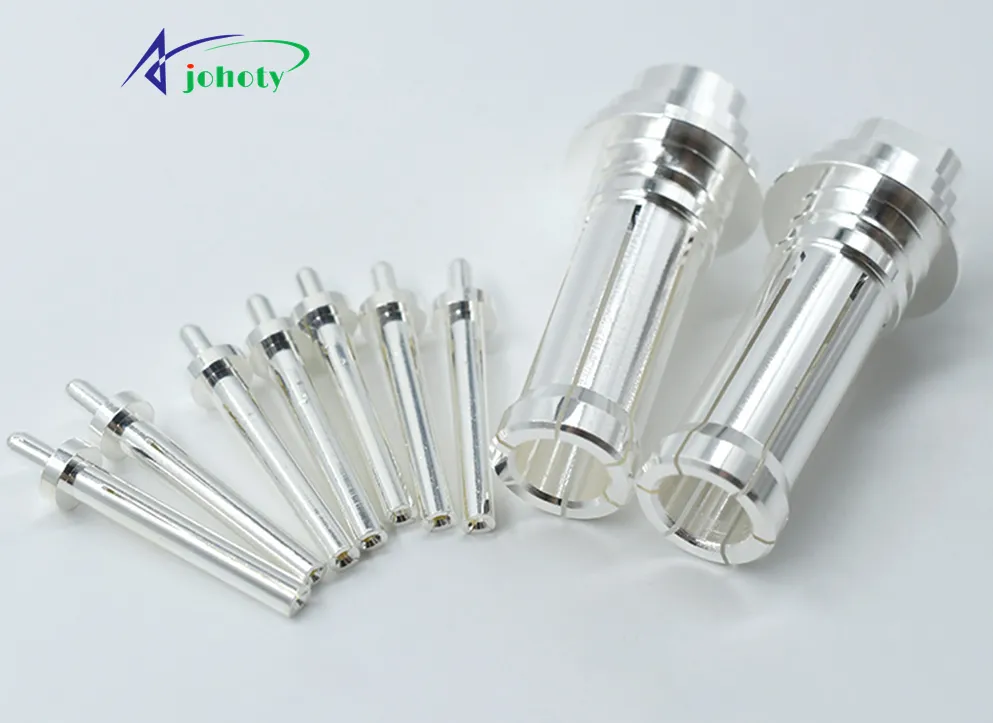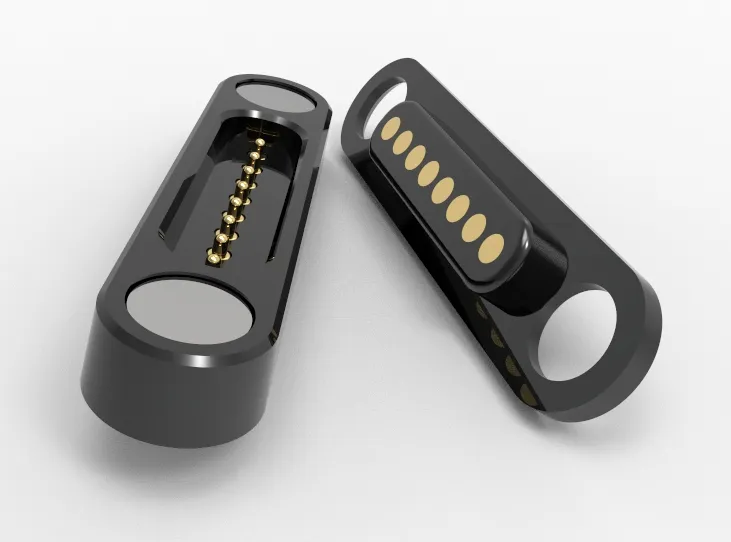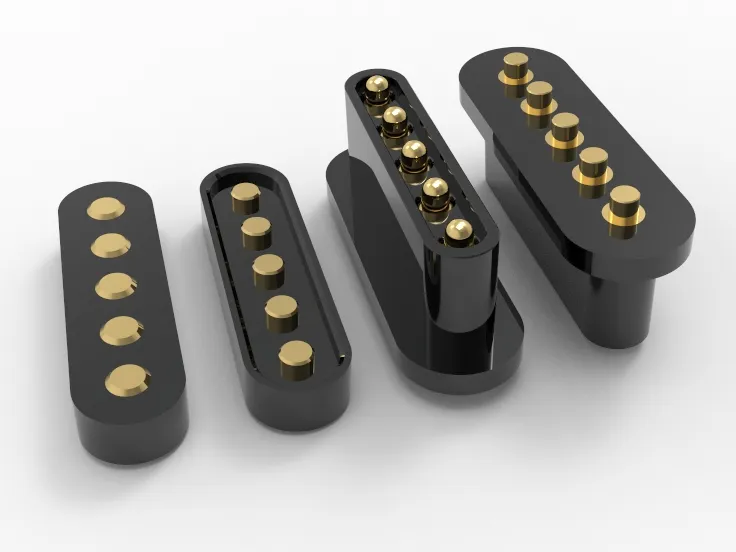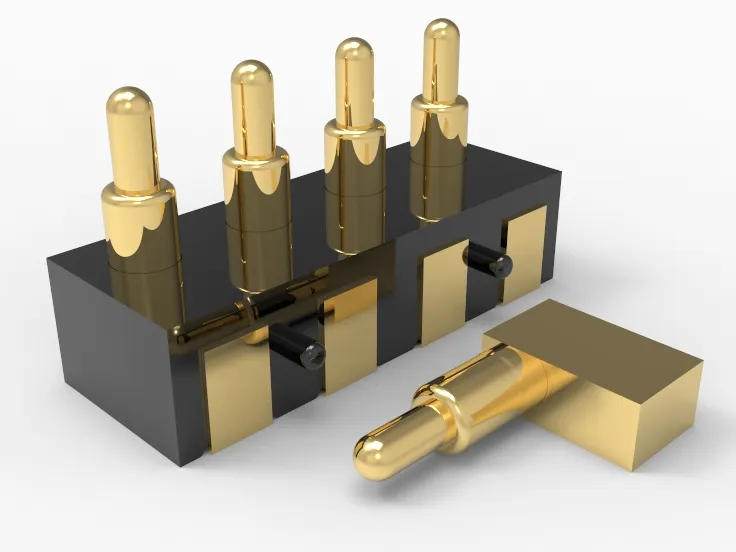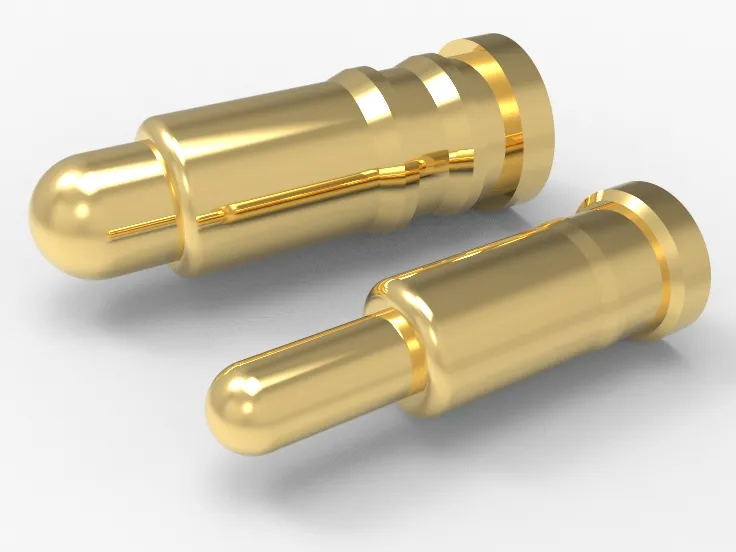What Is Quality Control? Delve Into Quality Control Principles Applied to Pogo Pin Connector for Optimal Durability, Function, Reliability
1. What is Quality Control?
Quality control is crucial in the production and use of Pogo pin connector to ensure excellent performance in demanding applications. Here’s a breakdown of essential quality control aspects:
- Contact Pressure Control Proper contact pressure is key to connector performance, affecting stability and durability. Accurate pressure ensures stable current transfer and prevents connection issues. Monitoring spring compression and elasticity is vital to avoid faults.
- Durability Testing Pogo Pins often endure frequent plug-ins, so durability is a focus. They should withstand thousands of operations without performance loss. Testing simulates real conditions to ensure reliable long-term performance.
- Coating Quality Coatings like gold or silver enhance conductivity and corrosion resistance. Uniformity, thickness, and adhesion are checked to prevent coating failure. Specialized equipment measures coating thickness and adhesion strength.
- Dimensional Accuracy Precision in dimensions is crucial for overall performance. Small deviations can cause connection issues. High-precision tools check each batch to ensure parts are within tolerance.
- Material Selection Materials affect electrical performance and mechanical strength. Conductive parts use high-conductivity materials like copper, while insulating parts need high heat resistance and durability. Material quality is verified through supplier audits and random checks.
- Soldering Process Soldering is critical to assembly quality. Controlling temperature, time, and solder use, and using X-ray inspections ensure reliable solder joints.
- Environmental Testing Connectors must perform in extreme conditions. Environmental tests like thermal cycling, salt spray, and vibration ensure reliable operation under harsh environments.
- Process Traceability Every production step is recorded for quality control. From raw material intake to pogo pin connector shipping, detailed records help quickly identify and address any issues.
These measures ensure Pogo pin connector is stable, reliable, and boost customer trust and market competitiveness.
2. What is Quality Control? Its Crucial Role in Pogo pin connector
Quality control is essential in the design and production of Pogo pin connector. These high-precision electronic connectors are vital for the stability and safety of entire devices. Ensuring top quality in every Pogo Pin connector is therefore crucial.
- Importance of Quality Control Pogo pin connector must maintain stable electrical and mechanical performance in complex environments. Even minor flaws can cause system failures. Quality control ensures product compliance, long-term stability, and safety through rigorous standards and multiple checks at each stage, from design to production.
- Quality Control in the Design Stage During the design phase, quality control focuses on design feasibility and practicality. Engineers must ensure that the connector’s structure suits various scenarios and addresses potential stress, wear, and resistance changes. Every design detail is validated through simulations and sample tests to meet high standards.
- Importance of Material Selection The choice of materials affects the conductivity, wear resistance, and corrosion resistance of Pogo pin connector. Quality control involves thorough vetting of suppliers and multiple tests of materials. Using subpar materials can lower performance, raise costs, and cause early product failure.
- Precision in Production In production, quality control focuses on meticulous manufacturing and assembly processes. Given the tiny size and complex structure of Pogo pin connector, even minor deviations can affect product quality. Each production step requires precise equipment and strict standards, combining automated and manual inspections to ensure accuracy.
- Final Product Testing After production, Pogo pin connector undergord rigorous final testing. This includes checks for electrical performance, mechanical strength, and corrosion resistance. Only Pogo Pin Connector that passes these tests is released to the market, ensuring quality control and product reliability.
- Ongoing Quality Improvement Quality control is a constantly changing process that needs ongoing upgrades. As technology and market demands evolve, so must the design and production processes of Pogo pin connector. By gathering market feedback and analyzing failures, quality control can enhance connector quality and reliability.
From start to finish, quality control is crucial for Pogo Pin connectors. Through stringent quality measures, every connector is ensured to perform reliably and efficiently in all environments, providing dependable connectivity solutions.
3. What is Quality Control? Key Strategies for Enhancing the Durability and Functionality of Pogo Pin Connector
- Material Selection and Validation: High-quality Pogo pin connector starts with superior raw materials. Using high-purity metals like gold or nickel plating prevents oxidation and corrosion, enhancing conductivity and longevity. Materials should be tested for tensile strength, hardness, and corrosion resistance before production to meet design requirements.
- Precision in Manufacturing Processes: Consistency in manufacturing is crucial for reliable products. Every step, from pressing to plating and assembly, must adhere to strict parameters, managed by automated systems and real-time monitoring to minimize human error and ensure uniform quality.
- Contact Pressure Control and Testing: Contact pressure is vital for connector performance. Too much pressure can cause wear, while too little can lead to poor contact. Precision equipment should adjust and control pressure during production, with multiple cycle tests to ensure pressure stays within design limits and remains stable over time.
- Environmental Stress Testing: Pogo pin connector often faces temperature, humidity, and vibration. Environmental stress tests, including thermal cycling, humidity tests, and vibration tests, ensure the connectors perform reliably in extreme conditions.
- Fatigue Life Testing: Connectors endure frequent insertion and removal, making fatigue testing essential. High-frequency insertion tests simulate wear and assess electrical performance and mechanical strength over multiple uses, ensuring long-term reliability.
- Automated Online Inspection: To meet high-quality standards, automated online inspection equipment is essential. Optical inspection, electrical performance tests, and dimensional accuracy checks monitor each connector in real-time, catching and discarding defects to ensure products meet expected standards.
By implementing these rigorous quality control strategies, the long-term stability and reliability of Pogo pin connector can be significantly improved, ensuring excellent performance in various applications.
4. What is Quality Control? Principles for Effective Implementation
In the production of Pogo pin connector, quality control is essential. Here’s how it’s done to ensure top standards:
- Continuous Testing and Real-Time Monitoring: Use advanced equipment to monitor key parameters like size tolerance, coating thickness, and spring force during production. If there are any issues, data is quickly sent to a central hub for correction.
- Employee Quality Awareness Training: Quality control relies not only on technology but also on trained staff. All employees, from the production line to management, receive regular training to understand and maintain high standards.
- Strict Process Validation: New processes or materials undergo rigorous testing to ensure they don’t negatively affect product quality and meet customer requirements.
- Statistical Process Control (SPC): SPC techniques analyze production data to spot trends and prevent quality issues before they arise, keeping the process within acceptable quality limits.
- Zero Defects Philosophy: Implement a zero-defect strategy, aiming for 100% product quality. We treat all defects as big issues, finding their root causes and taking corrective steps.
- Continuous Improvement (CI) and PDCA Cycle: Use the PDCA (Plan-Do-Check-Act) cycle to continuously refine quality control measures, addressing factors that impact product quality through ongoing monitoring and evaluation.
- Quality Traceability System: Maintain a traceability system to record production details like material batches, equipment status, and operators. This helps quickly identify and resolve quality issues, preventing recurrence.
These quality control measures ensure that each Pogo Pin connector meets or exceeds industry standards, enhancing market competitiveness and customer satisfaction.
5. What is Quality Control? Common Challenges and Solutions for Pogo Pin Connector
5.1. Inconsistent Contact Force
- Challenge: Variations in contact force can arise due to material choices and process issues, affecting connection reliability.
- Solution: Use precise spring materials, control compression ratios strictly, and test each Pogo Pin with advanced equipment to ensure design specifications are met.
5.2. Insulation Layer Damage
- Challenge: Mechanical damage or chemical corrosion can impair electrical insulation.
- Solution: Use high-quality insulation materials, apply protective measures like protective films and temperature control, and monitor the production environment to prevent chemical damage.
5.3. Soldering Issues
- Challenge: Bad soldering can result in weak or incomplete connections.
- Solution: Optimize soldering processes, match solder material with temperature, use precise automated soldering equipment, and inspect solder joints to meet quality standards.
5.4. Dimension Accuracy
- Challenge: Poor dimensional accuracy can lead to poor fit between pins and sockets.
- Solution: Use high-precision equipment and molds, and conduct rigorous size checks during production to ensure dimensional conformity.
5.5. Poor Surface Treatment
- Challenge: Subpar surface treatment can cause corrosion or reduce conductivity.
- Solution: Choose quality surface treatment materials, like nickel or gold plating, control process parameters strictly, and perform regular corrosion resistance tests.
5.6. Environmental Control
- Challenge: Temperature and humidity fluctuations can affect production quality.
- Solution: Implement temperature and humidity control systems in the production area, regularly monitor the environment, and maintain and calibrate equipment.
5.7. Waterproof Coating Integrity
- Challenge: High-temperature soldering can damage waterproof coatings.
- Solution: Use high-temperature-resistant waterproof coatings, test thoroughly before soldering, and consider low-temperature soldering techniques to minimize coating damage.
5.8. Contact Point Wear
- Challenge: Long-term use can cause wear on contact points, affecting stability.
- Solution: Use wear-resistant materials, such as precious metal coatings, and design appropriate contact forces to reduce wear.
5.9. Electrical Conductivity Stability
- Challenge: Variability in conductivity can occur due to material or process issues.
- Solution: Control raw material quality, implement comprehensive testing, and regularly review production processes to maintain high conductivity standards.
5.10. Mechanical Structure Stability
- Challenge: Structural deformation during use can impact functionality.
- Solution: Optimize design for mechanical stability, use high-strength materials, and ensure reliable design parameters.
5.11. Consistency in Production
- Challenge: Variations in size and shape during production.
- Solution: Enforce strict production controls, use high-precision molds and automation, and conduct regular quality audits to address production issues.
These solutions address common quality control challenges in Pogo Pin production, enhancing product reliability and performance while improving market competitiveness.
6. What is Quality Control? How Does It Enhance the Market Competitiveness of Pogo Pin Connector?
Quality control is crucial for boosting the market competitiveness of Pogo pin connector:
6.1 Strict Raw Material Testing
- Background: The performance of Pogo pin connector relies largely on the materials they’re made from. Material purity, strength, and corrosion resistance directly impact the connector’s performance.
- Measures: Conduct thorough testing and screening of raw materials to ensure they meet international and industry standards, avoiding subpar or defective materials.
- Results: Enhances durability and reliability, reduces failure rates, and boosts market competitiveness.
6.2 Precise Production Processes
- Background: High-precision manufacturing is key to ensuring Pogo Pin connector quality. Every step in production impacts how well the final product performs.
- Measures: Use advanced automation equipment and technology, maintain and calibrate machinery regularly to control every production phase.
- Results: Improves product consistency and accuracy, reduces human errors, and strengthens market edge.
6.3 Rigorous Quality Inspection
- Background: Quality inspection ensures each Pogo Pin connector meets specifications.
- Measures: Implement multi-stage inspections—incoming, process, and final inspections—to ensure each batch meets design standards.
- Results: Finds and resolves production issues fast, maintains consistent quality, and improves the brand’s image.
6.4 Effective Durability Testing
- Background: Pogo pin connector must perform reliably under various conditions, making durability testing crucial.
- Measures: Test connectors under high temperature, humidity, and vibration conditions to simulate real-world scenarios.
- Results: Ensures stable performance in actual use, improves user satisfaction, and boosts market competitiveness.
6.5 Ongoing Technological Innovation
- Background: Continuous innovation helps Pogo pin connector stays technologically advanced.
- Measures: Invest in R&D for new materials, processes, and designs to enhance product performance and value.
- Results: Establishes a technology-leading image in the market, attracts more customers, and increases market share.
6.6 Customer Feedback Mechanism
- Background: Understanding customer experiences and needs helps improve product quality.
- Measures: Create a robust feedback system to collect and act on customer input regularly, adjusting product designs as needed.
- Results: Enhances product market adaptability and customer satisfaction, boosting market competitiveness.
By implementing strict quality control measures—including raw material testing, precise production processes, rigorous inspections, effective durability testing, ongoing innovation, and customer feedback mechanisms—Pogo pin connector’s market competitiveness can be significantly improved. These measures ensure product quality and reliability, enhance brand reputation, and help the company gain a competitive edge in the market.
7. What is Quality Control? Future Trends in Quality Control: Adapting to Emerging Technologies for Pogo pin connector
As technology advances, emerging technologies are increasingly impacting Pogo pin connector. Here’s how quality control is evolving and strategies to tackle these challenges:
7.1 Smart Quality Inspection
- Smart technology makes inspections more precise and efficient. Using advanced sensors and machine learning, quality control systems can watch production in real-time, catch defects on their own, and cut down on human mistakes.
7.2 Automated Production Lines
- Automation boosts production efficiency and consistency. Automated systems handle every stage, including welding, testing, and assembly, minimizing variability caused by manual operations. Future automation will handle more complex designs.
7.3 Data-Driven Quality Analysis
- Big data enhances quality analysis, making it more systematic. By analyzing production data, companies can identify issues and predict risks, allowing them to act proactively and reduce defects.
7.4 Advanced Materials
- New materials pose both challenges and opportunities. High-performance materials improve durability and stability but require specialized quality control. Future quality checks will need to address material performance and its impact on overall quality.
7.5 Eco-Friendly Production
- With stricter environmental regulations, eco-friendly production is crucial. Besides ensuring product quality, quality control needs to tackle environmental concerns, including minimizing waste and emissions and opting for recyclable materials.
7.6 Customization and Small-Batch Production
- Customization and small-batch production are on the rise, demanding higher quality control standards. Adapting to the complexities of small batches while maintaining quality is a key challenge, requiring flexible quality control strategies.
7.7 Global Supply Chain Management
- Global supply chains introduce new quality control issues due to varying standards and practices. Future quality control will need global standards and processes to ensure consistent quality across different supply chain segments.
7.8 Real-Time Feedback and Improvement
- Real-time feedback systems enable quick responses to quality issues. Monitoring production metrics helps quickly identify and resolve problems, improving overall quality and driving continuous improvement.
To handle the challenges of new technologies, future quality control will need to innovate and adjust. Through smart technology, automation, data analysis, advanced materials, eco-friendly practices, customization, global supply chain management, and real-time feedback, high-quality production and reliability for Pogo pin connector can be ensured.
Conclusion: Why Quality Control Determines the Success of Pogo Pin Connector
Quality control is crucial to the success of Pogo pin connector. It ensures that products meet strict standards during production, directly impacting their durability, functionality, and reliability. An excellent quality control system identifies and corrects defects promptly, reducing costs and risks associated with failures.
Ultimately, stringent quality control not only improves the performance of Pogo pin connector but also builds customer trust, helping the product stand out in a competitive market.






